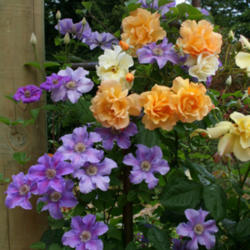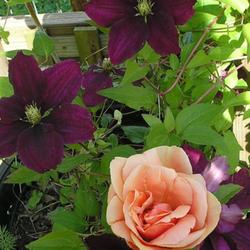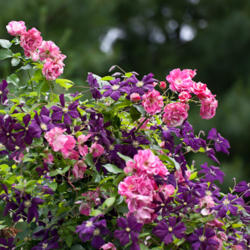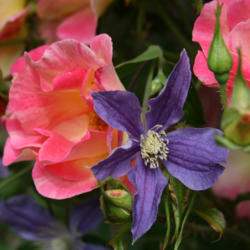Clematises and roses are ideal companions. They grow well in the same types of locations, thrive in the same types of soil, require the same amount of watering, and respond equally well to the same fertilizers.
I avoided growing clematises for a long time because the instructions sounded impossible: Keep the top in the sun and the bottom in the shade. How many locations offer that possibility? I soon learned to ignore the advice about the shade and to cover the base of the vine with a thick layer of mulch or even a piece of shale to keep it cool. ATP member Pirl provided me with these illustrations of “root-shading” methods. She guards the bottom of her clematis vines with a dense ground cover, a plant with good shading capacity, a thick layer of pine needle mulch, pine cones, bark, or a rock.



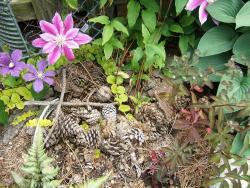


The best solution for me, however, is to plant the clematis close to a rose. The rose shades the clematis roots while allowing the clematis to climb through the rose foliage and bloom above the foliage, in the sun.
Clematis vines are not self-supporting plants, and they require structures or other plants to hold them up while they climb. They can be grown vertically with climbing roses or horizontally with shrub roses. The image on the left is of Clematis 'Ashva' climbing up Rosa 'Autumn Sunset,' and the image on the right is of Clematis 'Rooguchi' growing across a smaller rose, 'The Fairy.'
You have to consider the size of each plant, striving to choose pairs of equal size. Rambler roses should be avoided because they will overwhelm the clematis. By the same token, the armandii, montana, terniflora, and other vigorously spreading species of Clematis should be avoided because they will overwhelm the rose.
I occasionally have planted a rose and clematis in the same planting hole, but it’s best to plant them at least a foot apart to minimize their competition for water and nutrients and to facilitate the pruning of each without doing harm to the other.
Most people strive for a color contrast in their rose-clematis pairings. These examples of contrasting colors are, left to right, Clematis 'Niobe' and Rosa 'Duquesa de Penaranda'; Clematis x jackmanii 'Superba' and Rosa 'Berries 'n' Cream'; and Clematis 'Arabella' and Rosa 'Jacob's Robe.'
In this row, the contrasting pairs are, left to right, Clematis 'Ramona' and Rosa 'Graham Thomas'; Clematis 'Dawn' and Rosa 'Joseph's Coat'; and Clematis 'Romantika' and Rosa 'Berries 'n' Cream.'
A sharp contrast in color produces the most dramatic effect, of course, but contrasting bloom shapes on roses and clematises of harmonious colors can also be striking.
Roses and clematises that bloom at the same time may produce the best impact, but the ones that bloom at different times will extend the flowering season. You could grow three clematises to climb one rose, for example: an early-flowering clematis to provide color before the rose blooms, a mid-season clematis to bloom at the same time as the rose, and a late-flowering clematis to create a floral display when the rose is no longer blooming.






